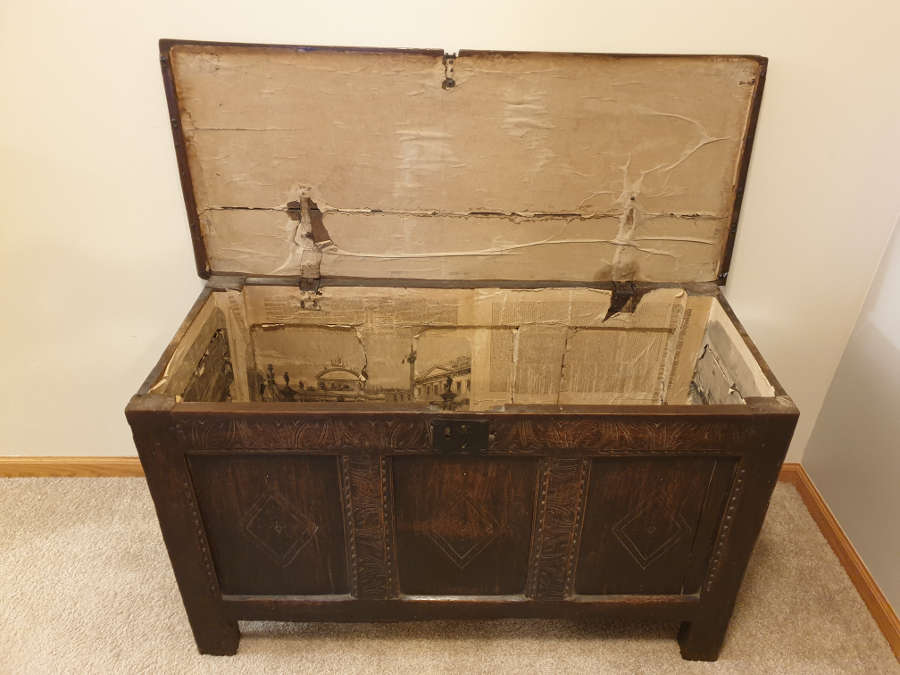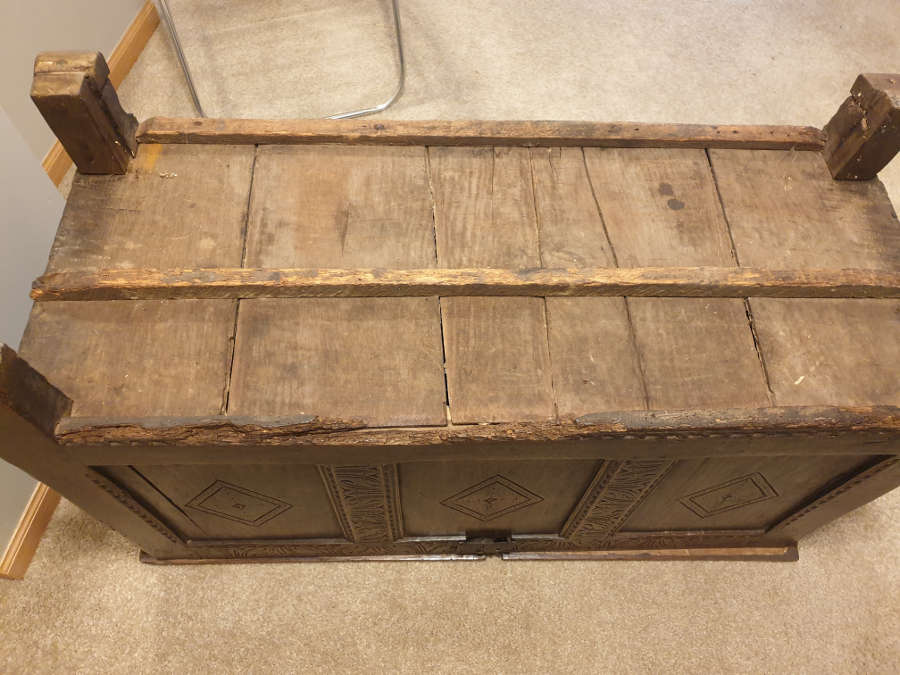You can find the first part of my observations here. I’ve been interested in oak coffers for quite some time. I think it was Peter Follansbee who initially made me aware of them quite a few years ago. While researching green woodworking I came across Mr Follansbee’s website where he talks about early American furniture makers, furniture-making tools, and processes. His website is always informative, inspirational, and extremely valuable when it comes to green woodworking, 17th-century furniture making, tools, and bird watching.
The oak coffer was made almost exclusively with mortise and tenon joinery, although there are a few exceptions to this where dovetails or butted and nailed edges were used. Some later versions were made of walnut and other local wood, but by and large, the earliest coffers were oak and made with mortise and tenon joinery. This put them under the strict control of the Joiners Guild (members of the “Mystery of the Joyners”). This meant that within the City of London (and to varying degrees, elsewhere in England) from the 15th to 17th centuries, the guild had the authority to search workshops. These inspectors would ensure that only members of the guild were making joined products and that the craftsmen who were members followed the guild procedures and processes. The Carpenters and Turners also had guilds, and over the centuries they competed and merged with the others. The history of the guilds in Europe and the UK is fascinating, and I’m sure I’ll go down that rabbit hole and write about it sometime in the near future.
You have been warned.
I had been looking at coffers for quite a while and had my eye on several. One of the first coffers that I had a good close look at was at a Lyon and Turnbull auction in Edinburgh in Nov 2018. This was my first good up-close look at a 17th-century oak coffer, and I was over the moon. My oh so patient wife watched me make a spectacle of myself as I bounced from piece to piece at that viewing, but the 17th-century pieces stole the show for me. Over the next year though, I’d see quite a few other coffers, newer and older and in better and worse shape, and so I ended up being able to make somewhat intelligent comparisons.


After almost a year in Scotland and then in England, looking at hundreds (if not thousands) of beautiful old pieces of furniture, and more specifically, oak coffers, we finally found one that fit our needs/desires. While living in March, Cambridgeshire in the UK, we purchased an oak coffer from the Risby Barn Antique Centre near Bury St. Edmunds. Since then, I’ve been slowly going over it to see how it was made, how it had been repaired, where it had lived, and trying to verify its age.

We had allotted up to a certain amount for our purchase, but this coffer that we decided on was well below that. It was sold as an “Early 17th-century plank top oak coffer” and even though I’d seen many of the same age in better condition, this one caught my eye because of the repairs and the newspaper that was used to line the interior. I decided on this one not just because of its beauty but also because of the story it would tell, which to me, is just as important.
As I mentioned, the newspaper lining was one of the first things I noticed that set this one apart from most of the others I’d seen. In fact, after going over all of my pictures I don’t believe I had seen any other ones with newspaper lining so, BIG WIN. There isn’t anything about the paper lining that adds to the monetary value of the piece and more likely, it decreased the value by hiding the interior. But for me, it provides clues to the history of the piece, which is valuable. I’m going to write specifically about the paper lining in a future post, but for this post I’m going to concentrate on the legs and feet and those repairs.
The legs are also the stiles of the panels and house the mortises for the side and front rails. The end grain of the feet have been soaking up any and all moisture on the floors for more than 300 years, and it is quite likely that the first several homes that this piece lived in had dirt floors.

The back legs have been damaged the most and after reading a bit about this it does make sense.


The back legs would have been up against an outside wall of either stone or wattle and daub (and no insulation or moisture barrier) so moisture and even standing water would not have been uncommon.
In the case of our coffer, the legs had probably deteriorated to the point that the person who repaired it simply had to cut them back to a point where they were not as rotted. That person then added two sections of new wood. The one behind the leg has the grain running vertically. This piece is likely to stabilize and strengthen the leg. The second section was on the bottom of the foot and had the grain running horizontally, so it would not wick as much moisture. This repair may have happened a century or so after it was built, but the next picture shows that the spliced piece behind the leg, as well as the block attached to the bottom, have been worn at an angle. This could mean one of two things. First, it might be that the person who added the repairs made the back legs too long and then cut the back legs at an angle to meet the front legs. I don’t think this is the case, but I could be wrong…Nah, I’m not wrong.

I think what really happened here is that after the back feet were repaired, the front feet also experienced deterioration that resulted in them losing a bit off the ends over the centuries. As the front feet wore down, the back feet wore at an angle to compensate. One other thing I’ve noticed is that the vertical piece that was scabbed onto the back of the leg may not be nearly as old as the horizontal piece added to the end of the foot. This because that piece doesn’t show any of the deterioration that you would expect if it had been soaking up moisture for several centuries.

This possibly means that the scabbed piece was added after the coffer moved to a home with non-dirt floors, thereby not wicking up as much moisture over the next hundred or so years.
For the next part of my observations, I’ll talk about the newspaper lining and how that fits into the piece’s history.
